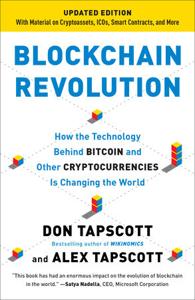
Want to learn the ideas in Blockchain Revolution better than ever? Read the world’s #1 book summary of Blockchain Revolution by Don Tapscott, Alex Tapscott here.
Read a brief 1-Page Summary or watch video summaries curated by our expert team. Note: this book guide is not affiliated with or endorsed by the publisher or author, and we always encourage you to purchase and read the full book.
Video Summaries of Blockchain Revolution
We’ve scoured the Internet for the very best videos on Blockchain Revolution, from high-quality videos summaries to interviews or commentary by Don Tapscott, Alex Tapscott.
1-Page Summary of Blockchain Revolution
Overview
The internet is the backbone of our modern world. However, it took a while for people to realize how useful it was. Similarly, Bitcoin is the currency that will power blockchain technology in this century. But before you can understand its usefulness, you need to know how to use it and earn your first bitcoins.
In 2008, the world was in financial turmoil. To solve this problem, a person named Satoshi Nakamoto came up with an idea that soon spread like wildfire among computer scientists and banks — anyone who had ever tried to establish trust on the internet.
We don’t know who the person behind the name Satoshi Nakamoto is, but that doesn’t matter. What matters is his/her idea: Bitcoin and blockchain technology.
In this passage, the author presents his key points. He will explain what blockchain technology is, how it can be used and why it has potential to change the world.
In this article, you will learn about the future of banking and how a few companies are making it obsolete. You’ll also find out why Airbnb and Uber aren’t part of the sharing economy, as well as which is faster: sending an anvil to China or sending money through banks.
Big Idea #1: A blockchain is a decentralized database that’s secure and trustworthy.
You might be skeptical of a seller who refuses to use banks or notaries, and for good reason. Banks have long served as the middleman between buyers and sellers by authenticating transactions and ensuring that property titles are correct. However, there’s no guarantee that the bank itself is trustworthy. More recently, businesses such as Uber and Airbnb have begun filling this role by vouching for their own drivers or apartment owners instead of the banks themselves.
Banks can go bankrupt and lose your money by making bad deals, companies like Uber sell customer data without getting consent from customers, and governments are capable of going bankrupt themselves.
The internet is a powerful tool for communication, but it lacks the security necessary to conduct big transactions. However, there’s a new technology that might change this perception of the internet in the future.
Blockchain technology is a way of managing transactions. It makes it possible for people to bypass traditional banking authorities by making all transactions transparent and decentralized, so that everyone involved can see what’s happening with the database.
When a transaction is made, it gets timestamped and added to the database. When that transaction doesn’t cause any issues within the system and when most people agree on it being legitimate, then the transaction is legitimated in a way which makes sure only normal transactions with no confusion take place over time.
Blockchain is a system of verification that makes it impossible for hackers to make changes without being noticed. It also doesn’t allow old entries to be changed, since no one entity controls the blockchain.
Big Idea #2: Blockchain is Cryptographically Secure
So you might be wondering why is it called blockchain? It’s because every record, which could contain multiple transactions, is called a block on the ever-growing database. And each new block links to all previous blocks in a chain. This makes the system very secure and safe from tampering or hacking.
New blocks are created by special nodes called miners. These contain a new set of transactions as well as links to the previous block and so on.
When a new block is added, the miner who found it will broadcast that information to other nodes in the network. The data will be checked by all of those nodes and if they agree on what’s in the block, then everything is fine.





